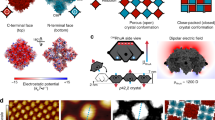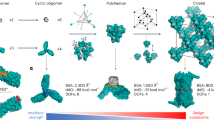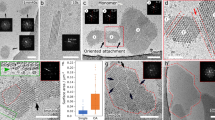Abstract
Two-dimensional (2D) crystalline materials possess unique structural, mechanical and electronic properties1,2 that make them highly attractive in many applications3,4,5. Although there have been advances in preparing 2D materials that consist of one or a few atomic or molecular layers6,7, bottom-up assembly of 2D crystalline materials remains a challenge and an active area of development8,9,10. More challenging is the design of dynamic 2D lattices that can undergo large-scale motions without loss of crystallinity. Dynamic behaviour in porous three-dimensional (3D) crystalline solids has been exploited for stimuli-responsive functions and adaptive behaviour11,12,13. As in such 3D materials, integrating flexibility and adaptiveness into crystalline 2D lattices would greatly broaden the functional scope of 2D materials. Here we report the self-assembly of unsupported, 2D protein lattices with precise spatial arrangements and patterns using a readily accessible design strategy. Three single- or double-point mutants of the C4-symmetric protein RhuA were designed to assemble via different modes of intermolecular interactions (single-disulfide, double-disulfide and metal-coordination) into crystalline 2D arrays. Owing to the flexibility of the single-disulfide interactions, the lattices of one of the variants (C98RhuA) are essentially defect-free and undergo substantial, but fully correlated, changes in molecular arrangement, yielding coherently dynamic 2D molecular lattices. C98RhuA lattices display a Poisson’s ratio of −1—the lowest thermodynamically possible value for an isotropic material—making them auxetic.
This is a preview of subscription content, access via your institution
Access options
Subscribe to this journal
Receive 51 print issues and online access
$199.00 per year
only $3.90 per issue
Buy this article
- Purchase on Springer Link
- Instant access to full article PDF
Prices may be subject to local taxes which are calculated during checkout



Similar content being viewed by others
References
Mas-Ballesté, R., Gómez-Navarro, C., Gómez-Herrero, J. & Zamora, F. 2D materials: to graphene and beyond. Nanoscale 3, 20–30 (2011)
Butler, S. Z. et al. Progress, challenges, and opportunities in two-dimensional materials beyond graphene. ACS Nano 7, 2898–2926 (2013)
Schedin, F. et al. Detection of individual gas molecules adsorbed on graphene. Nature Mater. 6, 652–655 (2007)
Lu, C.-H., Yang, H.-H., Zhu, C.-L., Chen, X. & Chen, G.-N. A graphene platform for sensing biomolecules. Angew. Chem. 121, 4879–4881 (2009)
Joshi, R. K. et al. Precise and ultrafast molecular sieving through graphene oxide membranes. Science 343, 752–754 (2014)
Nicolosi, V., Chhowalla, M., Kanatzidis, M. G., Strano, M. S. & Coleman, J. N. Liquid exfoliation of layered materials. Science 340, 1226419 (2013)
Li, D., Muller, M. B., Gilje, S., Kaner, R. B. & Wallace, G. G. Processable aqueous dispersions of graphene nanosheets. Nature Nanotechnol. 3, 101–105 (2008)
Colson, J. W. et al. Oriented 2D covalent organic framework thin films on single-layer graphene. Science 332, 228–231 (2011)
Kissel, P., Murray, D. J., Wulftange, W. J., Catalano, V. J. & King, B. T. A nanoporous two-dimensional polymer by single-crystal-to-single-crystal photopolymerization. Nature Chem. 6, 774–778 (2014)
Kory, M. J. et al. Gram-scale synthesis of two-dimensional polymer crystals and their structure analysis by X-ray diffraction. Nature Chem. 6, 779–784 (2014)
Shimomura, S. et al. Selective sorption of oxygen and nitric oxide by an electron-donating flexible porous coordination polymer. Nature Chem. 2, 633–637 (2010)
Rabone, J. et al. An adaptable peptide-based porous material. Science 329, 1053–1057 (2010)
Serre, C. et al. Role of solvent-host interactions that lead to very large swelling of hybrid frameworks. Science 315, 1828–1831 (2007)
Sleytr, U. B., Schuster, B., Egelseer, E. M. & Pum, D. S-layers: principles and applications. FEMS Microbiol. Rev. 38, 823–864 (2014)
Hampp, N. Bacteriorhodopsin as a photochromic retinal protein for optical memories. Chem. Rev. 100, 1755–1776 (2000)
Engel, A. et al. Assembly of 2-D membrane protein crystals: dynamics, crystal order, and fidelity of structure analysis by electron microscopy. J. Struct. Biol. 109, 219–234 (1992)
Stahlberg, H. et al. Two-dimensional crystals: a powerful approach to assess structure, function and dynamics of membrane proteins. FEBS Lett. 504, 166–172 (2001)
Saboe, P. O. et al. Two-dimensional protein crystals for solar energy conversion. Adv. Mater. 26, 7064–7069 (2014)
Sinclair, J. C., Davies, K. M., Venien-Bryan, C. & Noble, M. E. M. Generation of protein lattices by fusing proteins with matching rotational symmetry. Nature Nanotechnol. 6, 558–562 (2011)
Brodin, J. D. et al. Metal-directed, chemically tunable assembly of one-, two- and three-dimensional crystalline protein arrays. Nature Chem. 4, 375–382 (2012)
Gonen, S., DiMaio, F., Gonen, T. & Baker, D. Design of ordered two-dimensional arrays mediated by noncovalent protein-protein interfaces. Science 348, 1365–1368 (2015)
Lanci, C. J. et al. Computational design of a protein crystal. Proc. Natl Acad. Sci. USA 109, 7304–7309 (2012)
Ringler, P. & Schulz, G. E. Self-assembly of proteins into designed networks. Science 302, 106–109 (2003)
Grueninger, D. et al. Designed protein-protein association. Science 319, 206–209 (2008)
Greaves, G. N., Greer, A. L., Lakes, R. S. & Rouxel, T. Poisson’s ratio and modern materials. Nature Mater. 10, 823–837 (2011)
Grima, J. N., Alderson, A. & Evans, K. E. Auxetic behaviour from rotating rigid units. Phys. Status Solidi B 242, 561–575 (2005)
Evans, K. E. & Alderson, A. Auxetic materials: functional materials and structures from lateral thinking! Adv. Mater. 12, 617–628 (2000)
Baughman, R. H. Auxetic materials: avoiding the shrink. Nature 425, 667 (2003)
Scarpa, F., Ciffo, L. G. & Yates, J. R. Dynamic properties of high structural integrity auxetic open cell foam. Smart Mater. Struct. 13, 49–56 (2004)
Lakes, R. Foam structures with a negative Poisson’s ratio. Science 235, 1038–1040 (1987)
Choi, J. B. & Lakes, R. S. Non-linear properties of metallic cellular materials with a negative Poisson’s ratio. J. Mater. Sci. 27, 5375–5381 (1992)
Kroemer, M. & Schulz, G. E. The structure of L-rhamnulose-1-phosphate aldolase (class II) solved by low-resolution SIR phasing and 20-fold NCS averaging. Acta Crystallogr. D58, 824–832 (2002)
Edelhoch, H. Spectroscopic determination of tryptophan and tyrosine in proteins. Biochemistry 6, 1948–1954 (1967)
Crowther, R., Henderson, R. & Smith, J. MRC image processing programs. J. Struct. Biol. 116, 9–16 (1996)
Mindell, J. A. & Grigorieff, N. Accurate determination of local defocus and specimen tilt in electron microscopy. J. Struct. Biol. 142, 334–347 (2003)
Valpuesta, J. M., Carrascosa, J. L. & Henderson, R. Analysis of electron microscope images and electron diffraction patterns of thin crystals of Ø29 connectors in ice. J. Mol. Biol. 240, 281–287 (1994)
Pettersen, E. F. et al. UCSF Chimera—a visualization system for exploratory research and analysis. J. Comput. Chem. 25, 1605–1612 (2004)
Heymann, J. B. Bsoft: image and molecular processing in electron microscopy. J. Struct. Biol. 133, 156–169 (2001)
Tang, G. et al. EMAN2: an extensible image processing suite for electron microscopy. J. Struct. Biol. 157, 38–46 (2007)
Schindelin, J. et al. Fiji: an open-source platform for biological-image analysis. Nature Methods 9, 676–682 (2012)
Schneider, C. A., Rasband, W. S. & Eliceiri, K. W. NIH Image to ImageJ: 25 years of image analysis. Nature Methods 9, 671–675 (2012)
Henderson, R., Baldwin, J. M., Downing, K. H., Lepault, J. & Zemlin, F. Structure of purple membrane from halobacterium halobium: recording, measurement and evaluation of electron micrographs at 3.5 Å resolution. Ultramicroscopy 19, 147–178 (1986)
Acknowledgements
We thank M. Sailor, H. Gray, R. Alberstein and F. Paesani for discussions, N. Olson and J. Bouwer for assistance with TEM measurements, and N. Gianneschi for the use of AFM and DLS instrumentation. This work was primarily supported by the US Department of Energy (DOE) (Division of Materials Sciences, Office of Basic Energy Sciences, Award DE-FG02-10ER46677 to F.A.T.). Y.S. and F.A.T. were partially supported (for EM measurements) by a grant from the Air Force Office of Scientific Research (AFOSR, BRI FA9550-12-1-0414). The EM facilities used in this work are supported by funding to T.S.B. from the NIH (1S10 RR-020016 and GM-033050), the Agouron Foundation and UCSD.
Author information
Authors and Affiliations
Contributions
Y.S. and F.A.T. conceived the work and designed the experiments. Y.S. carried out all experimental work and EM measurements. G.C. and Y.S. performed, and T.S.B. oversaw, EM data analysis. D.R. and P.D.Z. performed digital image-correlation analysis. F.A.T. and Y.S. wrote the manuscript with contributions from G.C., T.S.B., D.R. and P.D.Z.
Corresponding author
Ethics declarations
Competing interests
F.A.T. and Y.S. are inventors on two provisional patent applications based on the described work.
Extended data figures and tables
Extended Data Figure 1 TEM characterization of C98RhuA and H63/H98RhuA self-assembly under non-optimal conditions.
a, 25 μM C98RhuA was incubated at 4 °C under air exposure for 1 day; the solution contained 20 mM Tris (pH 8) and no reductants or oxidants. b, 25 μM H63/H98RhuA was incubated in the presence of 1 mM ZnCl2 at 4 °C for 1 day; the solution contained 20 mM MOPS (pH 7).
Extended Data Figure 2 TEM characterization of optimized 2D C98RhuA crystals.
a, 125 μM C98RhuA was incubated in the presence of 10 mM βME at 4 °C in a standing solution for 3 days. b, 125 μM C98RhuA was incubated in the presence of 10 mM βME at 4 °C with gentle shaking for 3 days, followed by 2 days at rest, during which a dense precipitate of crystals formed.
Extended Data Figure 3 Additional structural characterization of 2D C98RhuA crystals.
a, AFM; b, SEM; c, Cryo-TEM. The middle column in a shows the profiles along the arrows in the left column.
Extended Data Figure 4 TEM characterization of 2D H63/H98RhuA crystals.
a, b, 25 μM H63/H98RhuA was incubated with 200 μM ZnCl2 (a) or CuCl2 (b) in a 20 mM MOPS buffer solution (pH 7.0) at 4 °C for 1 day.
Extended Data Figure 5 TEM characterization of 2D F88/C98RhuA crystals.
a, 125 μM F88/C98RhuA was incubated in the presence of 10 mM βME at 4 °C with gentle shaking for 2 days. b, Schematic representations of various types of defects observed in F88/C98RhuA crystals, corresponding to boxed areas (I–IV) in a (colouring as in Fig. 1).
Extended Data Figure 6 Reversibility of oxidative or metal-mediated self-assembly of RhuA variants.
a, b, C98RhuA (a) and F88/C98RhuA (b) crystals. Left panels, the crystals were incubated in the presence of 20 mM or 30 mM βME (as indicated) and imaged by TEM at the indicated times after addition of βME. Right panels, 125 μM C98RhuA (a) or F88/C98RhuA (b) were incubated under oxidative self-assembly conditions (in the presence of 10 mM βME at 4 °C with gentle shaking) and self-assembly was monitored by DLS at t = 0 (top), t = 3 days (centre) and upon addition of 100 mM βME after self-assembly (bottom). Dh refers to the hydrodynamic diameter. c, Left panel, H63/H98RhuA crystals were incubated in the presence of 10 mM EDTA and imaged by TEM at 2 h after addition of EDTA. Right panels, 25 μM H63/H98RhuA was incubated under metal-mediated self-assembly conditions (in the presence of 200 μM ZnCl2 at 4 °C) and self-assembly was monitored by DLS at t = 0 (top), t = 3 days (centre) and upon addition of 10 mM EDTA (bottom). Scale bars are 5 μm in all panels.
Extended Data Figure 7 Characterization of the self-assembly of D98RhuA, C133RhuA and C266RhuA variants by TEM and DLS.
a, TEM (right panels) and DLS (left panels) characterization of D98RhuA self-assembly under oxidative or metal-mediated self-assembly conditions that were optimized for C98RhuA; see main text or Extended Data Figs 2 and 4 for details. b, Possible mode of disulfide-mediated self-assembly of C133RhuA (top panels) and TEM characterization of the self-assembly products obtained under conditions that were optimized for C98RhuA (bottom panels). c, Possible mode of disulfide-mediated self-assembly of C266RhuA (top panels) and TEM characterization of the self-assembly products obtained under conditions that were optimized for C98RhuA (bottom panels). No crystalline assemblies were detected under these conditions for any of these three variants (or other conditions that were used for screening C98RhuA self-assembly). Colouring in the top panels of b and c as in Fig. 1.
Extended Data Figure 8 Crystallographic analysis of the 2D lattices of RhuA variants.
a, (i) Representative Fourier transforms calculated from the full field of view of crystal images, displayed up to 10 Å. Reciprocal lattice axes are indicated with H and K. The reflections are consistent with the plane group symmetries estimated from the analysis of the phase residuals (see Supplementary Table 4). (ii) Integer quality (IQ) plots calculated from the spectra in column (i). The size of the boxes around the reflections reflects their IQ value, defined as the ratio of the reflection-peak amplitude and the amplitude of the background signal around each peak42. The most significant reflections are labelled with their IQ values, 1–4. Rings are displayed at resolutions of 30 Å, 15 Å and 10 Å. (iii) Overlap of fast Fourier transform and IQ plots. b, Crystallographic data for the 2D lattices of RhuA variants. Reported are the numbers of TEM images used for the analysis of plane group symmetry. The numbers in parentheses are the number of images used for determining the statistics for the unit-cell dimensions of each lattice. The plane group symmetry was determined by consensus from all the available images. c, Electron diffraction patterns of C98RhuA and H63/H98RhuA lattices.
Extended Data Figure 9 2D TEM reconstruction and structural modelling of the 2D lattices of RhuA variants.
a, Comparison of the observed (experimental) and simulated projection maps of the 2D lattices of RhuA variants. b, Molecular arrangements in C98RhuA, H63/H98RhuA and F88/C98RhuA lattices viewed from different angles (colouring as in Fig. 1). c, Representative images of 2D C98RhuA crystals containing no defects. d, Representative images of 2D C98RhuA crystals containing a single lattice vacancy. The stain artefact images are shown to highlight areas that may appear to contain lattice vacancies in low-magnification views, but actually do not.
Extended Data Figure 10 Conformational analysis of C98RhuA lattices.
a, Photographs of sedimented and resuspended C98RhuA crystals (alternative views with different backgrounds are shown for clarity). b, Representative TEM images for different conformational states (I–VII) of the C98RhuA crystals shown in Fig. 3. Scale bars are 25 nm in all panels. c, Digital image processing of reconstructed images of each conformational state. Red lines represent the border of the pores in the lattice structure. Selected RVEs are shown with green lines, with the vertices of the RVEs numbered 1–4. Blue lines show the circles circumscribed to the square RhuA building block. Values of the scaling between these and the TEM images (with conformational state I as a reference) are shown below each image. d, Changes in the dimensions of a C98RhuA lattice of arbitrary size assuming a rotating-rigid-squares model.
Supplementary information
Supplementary Information
This file contains Supplementary Figures 1-3 and Supplementary Tables 1-4. (PDF 4363 kb)
Illustrates the dynamics of 2D C98RhuA crystals starting from the TEM snapshots of the seven conformational states (I–VII; Fig. 3a).
All projected density images were rescaled to include the same field of view (bint and bimg from Bsoft). Twenty-four intermediate image frames were created between each pair in the sequence by pseudo-morphing, using the program convert from the software suite ImageMagick. (MOV 59 kb)
Rights and permissions
About this article
Cite this article
Suzuki, Y., Cardone, G., Restrepo, D. et al. Self-assembly of coherently dynamic, auxetic, two-dimensional protein crystals. Nature 533, 369–373 (2016). https://doi.org/10.1038/nature17633
Received:
Accepted:
Published:
Issue Date:
DOI: https://doi.org/10.1038/nature17633
This article is cited by
-
Design of supramolecular nanosheets for drug delivery applications
Polymer Journal (2023)
-
Agglomeration: when folded proteins clump together
Biophysical Reviews (2023)
-
Supramolecular assembling systems of hemoproteins using chemical modifications
Journal of Inclusion Phenomena and Macrocyclic Chemistry (2023)
-
Reconstitution of microtubule into GTP-responsive nanocapsules
Nature Communications (2022)
-
Free-standing homochiral 2D monolayers by exfoliation of molecular crystals
Nature (2022)
Comments
By submitting a comment you agree to abide by our Terms and Community Guidelines. If you find something abusive or that does not comply with our terms or guidelines please flag it as inappropriate.



